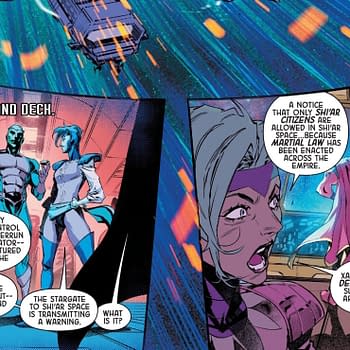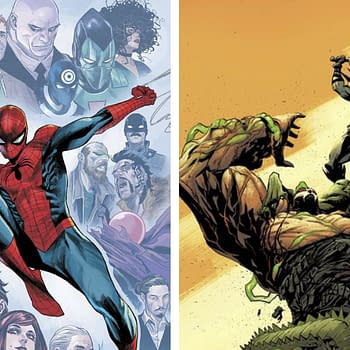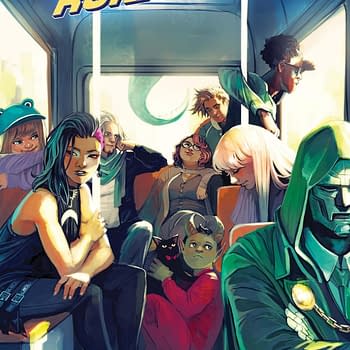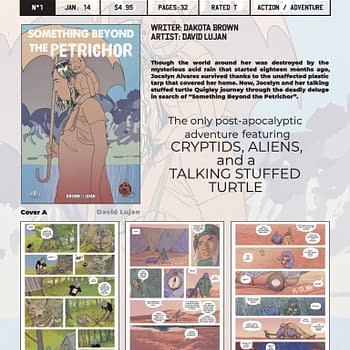Posted in: Comics | Tagged: amanda conner, before watchmen, Comics, power girl
Amanda Conner On Power Girl, Wonder Woman,Silk Spectre And Boobs
The word from DC Comics is that, of all the Before Watchmen titles, it will be next week's Silk Spectre series that will stand out critically above the others. Anna North interviewed Amanda Conner for Buzzfeed. With permission, we reprint that interview here. Check out Anna's other work tackling tech tweets, and the site's look at comic book heels and tween girl gaming.
Amanda Conner has drawn for such series as Power Girl, Painkiller Jane, Wonder Woman, and Vampirella. Now she's at work on an anime-inflected digital series called Ame-Comi Girls, and on a prequel to Watchmen about the adventures of Silk Spectre (played by Malin Akerman in the movie), the first issue of which comes out next week.

I try to ignore the controversy and just give each character a lot of individuality. For instance, there's a lot of controversy about Power Girl's boobs. Frankly, her big boobs are part of her whole persona. People asked me, "Why didn't you give her smaller boobs?" I said, "Then it's going to become all about the boobs." We wanted to acknowledge that she looks the way she looks and move on to the story. She just happens to be a character that has gigantic boobs.
I wouldn't draw Supergirl the same way, because in my head she's a teenage girl and she's not done growing yet. I try and give each individual character their own body type — I'd like to think I do it with male characters too. For instance, I would draw Nightwing leaner and more wiry than Batman or Superman.
Who are your favorite characters to draw?
Every time I get a new character to draw, that's my new favorite one. I do love drawing Power Girl, though — she is one of my all-time favorites. I'm also loving drawing Silk Spectre. The character that I'd love to draw the most that I haven't drawn before in comic book form would be Catwoman.
How do you prepare to draw a new character?
I look at the way they've been drawn before and try to stay true to that, but I also want to put my own spin on the character. I think about not just what will look really great, but about what I'll feel like drawing over and over again for the next year. I've given characters costume details before that ended up driving me nuts when I had to draw them over and over.

I like to read, but the funny thing is most of the stuff that I read isn't comic books or even fantasy or sci-fi, which is kind of ironic because that's the kind of stuff I work on. When I'm done working on it, I want to give my brain a break. My favorite author is Carl Hiaasen, and right now I'm reading a lot of Bill Bryson, one of the funniest travel writers I've ever read.
On TV, I love Game of Thrones — the last episode was on just the other night, so I'm worried about withdrawal.
What's the most exciting thing about your new Silk Spectre book?
The most exciting thing for me right now is that it's the biggest thing I've ever had a hand in writing [as opposed to drawing]. I've written small things here and there, but this is probably the largest thing that I've ever co-written. It's not something I'm used to doing, but I'm really enjoying it, and I'm hoping that I'm bringing something really good to it. It's an incredible honor to work on a character that I've found so inspirational.
How is writing different from doing the artwork for a comic book?
Since I'm not so used to it, writing is a lot harder than doing the art, even though art is very time-consuming. On this book I'm doing so much heavy-duty research — there's so much I want to get right involving the year its supposed to take place in, but it's also an alternate reality. I want it to be slightly different but also ring true.
Is it hard to be a woman working in the comic book world?
I've either been really lucky or blissfully ignorant. I went to the Kubert School [a technical school specializing in cartooning and graphic art] and it was almost all guys, and I do remember one of my teachers telling us that the comic book industry was one of the hardest industries to get into, whether you're a guy or a girl, so I just sort of mentally prepared for a struggle to get in. There may have been some discrimination thrown my way, but I wasn't looking at it like that, I was just looking at it like one of the hurdles I had to get past.
The only thing that irked me was when I went into the comic book shop near my parents' house when I was still living at home, and the guys working at the shop were sort of laughing at me, like, "a girl who wants to get into comics, sure." Instead of yelling, my plan was, "I'll show them." So I got a job at a comic book store that was close to them, and I made it a way better comics store than they had. They went out of business before us, too. I think maybe those guys spurred me on to work harder.
Thanks to













